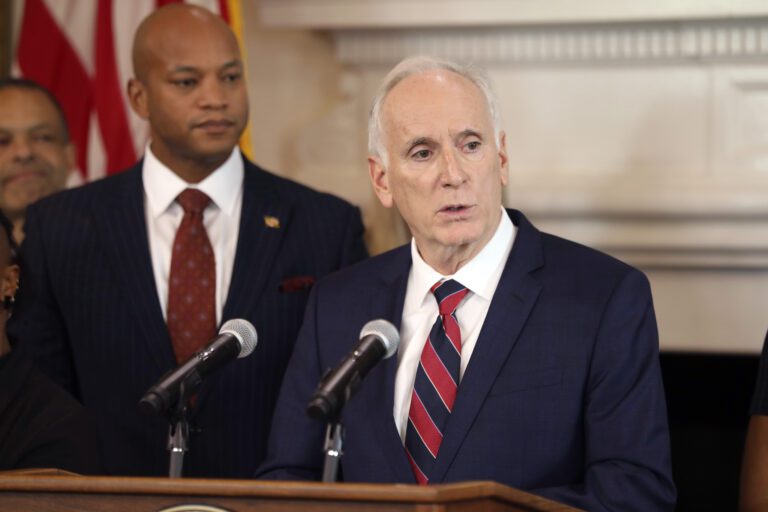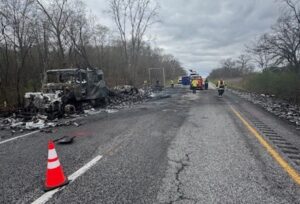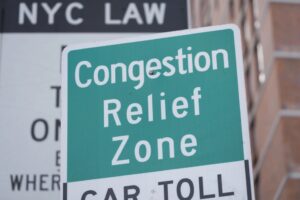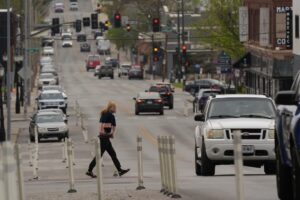ANNAPOLIS, Md. — Maryland Gov. Wes Moore’s administration is proposing roughly $3.3 billion in wide-ranging cuts for the state’s six-year transportation spending plan, which is facing inflationary pressures as traditional revenue sources haven’t kept up with costs, the state’s transportation secretary said Tuesday.
The proposal, which could be adjusted by the General Assembly next year, will have an impact on highways and transit service, as well as other transportation spending.
The approach includes about $1 billion in reductions in the transportation department’s operating budget, $2 billion from the capital program and about $400 million in grant reductions to local governments, the department said in a news release Tuesday.
“We’re trying to pull as many levers as we can to make this as painless as we can,” Paul Wiedefeld, Maryland’s transportation secretary, told The Associated Press in an interview.
The proposal is part of a larger budget challenge the state is facing. Moore, a Democrat, and the legislature, which is controlled by Democrats, are grappling with projected future budget deficits in the state’s operating budget, which is separate from the transportation spending plan.
Moore put officials on notice in August that tough budget decisions were coming, during a speech at the Maryland Association of Counties summer conference.
When state lawmakers convene for their annual legislative session in January, they will be working to balance the budget for the next fiscal year with an estimated shortfall of about $400 million. They also are facing rising budget gaps i n future years, as the state continues to implement an education funding reform law with phased-in funding.
One of the biggest cuts in the transportation funding plan would be to major highway and transit expansion projects that are not advertised by Jan. 1. Those construction dollars would be moved out beyond fiscal year 2029, Wiedefeld said.
The plan also would cut funds for maintenance projects by 30%. For highways, that reduction would affect day-to-day operations such as mowing lawns, picking up litter and fixing potholes.
“They’re still going to be doing them, but not at the degree that we would prefer,” Wiedefeld said.
The plan also calls for saving roughly $40 million a year by shutting down smaller branch offices for the MVA and reducing office hours. The plan also includes increasing airport parking fees.
Wiedefeld said the state will maintain matching money to receive federal funding. The transportation department said federal investments add up to about $7 billion.
“We’re not going to leave any money on the table because you’re getting roughly 80 cents on the dollar,” Wiedefeld said.
U.S. Rep. David Trone, a Democrat who represents western Maryland and parts of Montgomery County in the suburbs of the nation’s capital, criticized the plan for using funds in the federal Infrastructure Investment and Jobs Act to backfill the department’s budget. In a letter to Wiedefeld, Trone wrote that the plan would re-allocate funds from 12 of 33 approved priority roadway projects, reduce transit services and cut maintenance projects.
“These projects were a huge win and Marylanders were excited to see these long-awaited investments being made in their communities, as well as the thousands of good-paying jobs that would come with them,” Trone wrote.
The proposal retains project development funds for Baltimore’s Red Line, Southern Maryland Rapid Transit, the Frederick Douglass Tunnel Project, the replacement American Legion Bridge and other key projects, the transportation department said in a news release Tuesday afternoon.
The secretary, a former general manager and CEO of Metro, said Maryland won’t back away from investments needed to support the subway system linking Maryland and Virginia with the District of Columbia.
The funding crunch comes as revenue sources have not kept up with operating costs, Wiedefeld said. Operating costs have risen roughly 7% annually, while revenues have gone up only about 1%, he said.
The state’s vehicle titling tax isn’t keeping up with costs, as more people keep their vehicles longer, and the gas tax also doesn’t keep pace because of increasing efficiency and electric car use. Wiedefeld also noted that transit ridership has not bounced back to what it was before the COVID-19 pandemic.
The secretary also pointed out that the state has hit a debt-limit cap, creating another challenge for capital needs.
Despite the difficulties, Wiedefeld noted that Maryland will still be spending almost $20 billion in the transportation spending plan.
“We are building projects out there today, and we’re not stopping things that are under construction,” Wiedefeld said. “We have bus purchases in the future. all of those things are still funded. It’s just that where we’d like to be, we can’t afford right now.”
The Associated Press is an independent global news organization dedicated to factual reporting. Founded in 1846, AP today remains the most trusted source of fast, accurate, unbiased news in all formats and the essential provider of the technology and services vital to the news business. The Trucker Media Group is subscriber of The Associated Press has been granted the license to use this content on TheTrucker.com and The Trucker newspaper in accordance with its Content License Agreement with The Associated Press.








